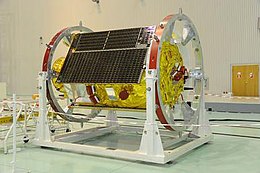 | |
| Mission type | Remote sensing |
|---|---|
| Operator | NARSS |
| COSPAR ID | 2014-021A[1][2] |
| SATCAT no. | 39678[2] |
| Website | www |
| Mission duration | Planned: 11 years[3] Final: 363 days |
| Spacecraft properties | |
| Bus | 559GK[1] |
| Manufacturer | RSC Energia[4] |
| Launch mass | 1,050 kilograms (2,310 lb)[1][5] |
| Power | 3000 watts[3][6] |
| Start of mission | |
| Launch date | April 16, 2014, 16:20 UTC[6] |
| Rocket | Soyuz-U |
| Launch site | Baikonur 31/6 |
| End of mission | |
| Last contact | April 14, 2015 |
| Orbital parameters | |
| Regime | LEO |
| Perigee altitude | 436 kilometres (271 mi) |
| Apogee altitude | 703 kilometres (437 mi) |
| Inclination | 51.6 degrees |
| Period | 96.05 min |
| Epoch | 17 April 2014, 04:55 UTC[2] |
| Main | |
| Name | EgyptSat 2 |
| Resolution | 1 metre (3 ft 3 in) (Pan)[4] 4 metres (13 ft) (MS)[4] |
EgyptSat | |
EgyptSat 2 was Egypt's second remote sensing Earth observation satellite. It was built by the Russian RSC Energia and the Egyptian NARSS while the incorporated cameras and payload was developed by OAO Peleng and NIRUP Geoinformatsionnye Sistemy in Belarus.[1][4]
A frameless spacecraft had been utilized in EgyptSat 2; it was an innovative technology being first time used in Russia.[7][8]
EgyptSat 2 was launched on board a Soyuz-U rocket on 16 April 2014 from the Baikonur Cosmodrome[9] which was a milestone toward establishing the Egyptian Space Agency.[10]
- ^ a b c d "EgyptSat 2 (MisrSat 2)". Gunter's Space Page. Retrieved 17 April 2014.
- ^ a b c "2014 - Launches to Orbit and Beyond". Zarya Soviet, Russian and international space flight. Retrieved 18 April 2014.
- ^ a b "EgyptSat-2 (MisrSat-2) spacecraft launch". Center for Operation of Space Ground-Based Infrastructure. Archived from the original on 16 April 2014. Retrieved 17 April 2014.
- ^ a b c d Anatoly Zak (25 April 2015). "EgyptSat-2 spy satellite". RussianSpaceWeb.com. Retrieved 23 September 2015.
- ^ "Satellite: EgyptSat-2". Observing Systems Capability Analysis and Review Tool. Retrieved 17 April 2014.
- ^ a b "Soyuz-U - EgyptSat-2 Launch Updates". spaceflight101. Archived from the original on 24 September 2015. Retrieved 23 September 2015.
- ^ "Technology has helped reduce satellite assembly time". Rostec. Archived from the original on 6 October 2014. Retrieved 29 September 2014.
- ^ "Rt-chemcomposite.ru" «РТ-Химкомпозит» сократил срок сборки космических аппаратов. РТ-Химкомпозит (in Russian). 18 April 2014. Retrieved 29 September 2014.
- ^ "Egyptian reconnaissance satellite launched by Soyuz". spaceflightnow. Retrieved 25 April 2014.
- ^ "Egyptsat-2 a Step Towards Egyptian Space Agency". allafrica. Retrieved 25 April 2014.